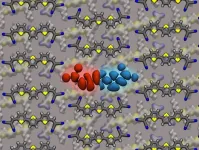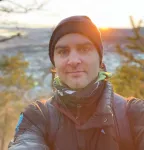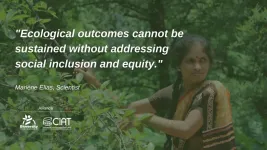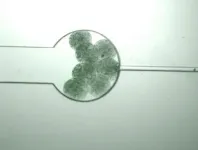Tuning the energy gap: A novel approach for organic semiconductors
2021-06-10
(Press-News.org) Organic semiconductors have earned a reputation as energy efficient materials in organic light emitting diodes (OLEDs) that are employed in large area displays. In these and in other applications, such as solar cells, a key parameter is the energy gap between electronic states. It determines the wavelength of the light that is emitted or absorbed. The continuous adjustability of this energy gap is desirable. Indeed, for inorganic materials an appropriate method already exists - the so-called blending. It is based on engineering the band gap by substituting atoms in the material. This allows for a continuous tunability as, for example in aluminum gallium arsenide semiconductors. Unfortunately, this is not transferable to organic semiconductors because of their different physical characteristics and their molecule-based construction paradigm, thus making continuous band gap tuning much more difficult.
However, with their latest publication scientists at the Center for Advancing Electronics Dresden (cfaed, TU Dresden) and at the Cluster of Excellence "e-conversion" at TU Munich together with partners from University of Würzburg, HU Berlin, and Ulm University for the first time realized energy-gap engineering for organic semiconductors by blending.
For inorganic semiconductors, the energy levels can be shifted towards one another by atomic substitutions, thus reducing the band gap ("band-gap engineering"). In contrast, band structure modifications by blending organic materials can only shift the energy levels concertedly either up or down. This is due to the strong Coulomb effects that can be exploited in organic materials, but this has no effect on the gap. "It would be very interesting to also change the gap of organic materials by blending, to avoid the lengthy synthesis of new molecules", says Prof. Karl Leo from TU Dresden.
The researchers now found an unconventional way by blending the material with mixtures of similar molecules that are different in size. "The key finding is that all molecules arrange in specific patterns that are allowed by their molecular shape and size", explains Frank Ortmann, a professor at TU Munich and group leader at the Center for Advancing Electronics Dresden (cfaed, TU Dresden). "This induces the desired change in the material´s dielectric constant and gap energy."
The group of Frank Ortmann was able to clarify the mechanism by simulating the structures of the blended films and their electronic and dielectric properties. A corresponding change in the molecular packing depending on the shape of the blended molecules was confirmed by X-ray scattering measurements, performed by the Organic Devices Group of Prof. Stefan Mannsfeld at cfaed. The core experimental and device work was done by Katrin Ortstein and her colleagues at the group of Prof. Karl Leo, TU Dresden.
The results of this study have just been published in the renowned journal Nature Materials. While this proves the feasibility of this type of energy-level engineering strategy, its employment will be explored for optoelectronic devices in the future.
INFORMATION:
Publication:
Band gap engineering in blended organic semiconductor films based on dielectric interactions. Katrin Ortstein, Sebastian Hutsch, Mike Hambsch, Kristofer Tvingstedt, Berthold Wegner, Johannes Benduhn, Jonas Kublitski, Martin Schwarze, Sebastian Schellhammer, Felix Talnack, Astrid Vogt, Peter Bäuerle, Norbert Koch, Stefan C. B. Mannsfeld, Hans Kleemann, Frank Ortmann and Karl Leo. Nature Materials Published online: 10 June, 2021
DOI: 10.1038/s41563-021-01025-z
Link: https://www.nature.com/articles/s41563-021-01025-z
This research was funded by the German Research Foundation (DFG) and partly by the Cluster of Excellence e-conversion through Germany´s Excellence Strategy.
Media inquiries:
Prof. Karl Leo
Dresden Integrated Center for Applied Physics and Photonic Materials
TU Dresden
Tel. +49 351 463-37533
karl.leo@iapp.de
http://www.iapp.de
Prof. Frank Ortmann
Department of Chemistry
TU München
Tel.: +49 89 289 13611
frank.ortmann@tum.de
https://www.department.ch.tum.de/tms
[Attachments] See images for this press release:

ELSE PRESS RELEASES FROM THIS DATE:
2021-06-10
Leipzig. Soot particles from oil and wood heating systems as well as road traffic can pollute the air in Europe on a much larger scale than previously assumed. This is what researchers from the Leibniz Institute for Tropospheric Research (TROPOS) conclude from a measurement campaign in the Thuringian Forest in Germany. The evaluation of the sources showed that about half of the soot particles came from the surrounding area and the other half from long distances. From the researchers' point of view, this underlines the need to further reduce emissions of soot that ...
2021-06-10
It is generally agreed that sperms "swim" by beating or rotating their soft tails. However, a research team led by scientists from City University of Hong Kong (CityU) has discovered that ray sperms move by rotating both the tail and the head. The team further investigated the motion pattern and demonstrated it with a robot. Their study has expanded the knowledge on the microorganisms' motion and provided inspiration for robot engineering design.
The research is co-led by Dr Shen Yajing, Associate Professor from CityU's Department of Biomedical Engineering (BME), and Dr Shi Jiahai, Assistant Professor of the Department of Biomedical Sciences (BMS). Their findings have been published in ...
2021-06-10
An electrode coating just one molecule thick can significantly enhance the performance of an organic photovoltaic cell, KAUST researchers have found. The coating outperforms the leading material currently used for this task and may pave the way for improvements in other devices that rely on organic molecules, such as light-emitting diodes and photodetectors.
Unlike the most common photovoltaic cells that use crystalline silicon to harvest light, organic photovoltaic cells (OPVs) rely on a light-absorbing layer of carbon-based molecules. Although OPVs cannot yet rival the performance of silicon cells, they could be easier and cheaper to manufacture at a very large scale using ...
2021-06-10
The type of material present under glaciers has a big impact on how fast they slide towards the ocean. Scientists face a challenging task to acquire data of this under-ice landscape, let alone how to represent it accurately in models of future sea-level rise.
"Choosing the wrong equations for the under-ice landscape can have the same effect on the predicted contribution to sea-level rise as a warming of several degrees", says Henning Åkesson, who led a new published study on Petermann Glacier in Greenland.
Glaciers and ice sheets around the world currently lose more than 700,000 Olympic swimming pools of water every day. Glaciers form by the transformation of snow into ice, which is later melted by ...
2021-06-10
With the start of the United Nations' Decade on Ecosystem Restoration, which runs through 2030, a tremendous amount of money and effort will be put into re-growing forests, making over-exploited farmland productive, and reviving damaged marine environments. This is a good, and vital, initiative. Without quick action to clean up the fallout of humanity's scorched-earth economic systems, goals on hunger, biodiversity and climate will be unattainable.
But in examining restoration projects already underway across the globe, a group of scientists has found that restoration action is at risk of failure if it doesn't make ...
2021-06-10
Palaeoclimatologists study climate of the geological past. Using an innovative technique, new research by an international research team led by Niels de Winter (VUB-AMGC & Utrecht University) shows for the first time that dinosaurs had to deal with greater seasonal differences than previously thought.
De Winter: "We used to think that when the climate warmed like it did in the Cretaceous period, the time of the dinosaurs, the difference between the seasons would decrease, much like the present-day tropics experience less temperature difference between ...
2021-06-10
Inaccessible workplaces, normative departmental cultures and 'ableist' academic systems have all contributed to the continued underrepresentation and exclusion of disabled researchers in the Geosciences, according to an article published today (Thursday 8 June) in Nature Geosciences.
The article argues that changes to both working spaces and attitudes are urgently needed if institutions are to attract, safeguard and retain people with disabilities.
Anya Lawrence, a disabled early career researcher in the University of Birmingham's School of Geography, Earth and Environmental Science and author of the piece says:
"Disabled geoscientists like myself face barrier after barrier on a daily ...
2021-06-10
People who smoke, suffer from high blood pressure, obesity, or diabetes are not only at greater risk of suffering a stroke, heart attack, or dementia. For them, the risk of being affected by depressive mood or depression also increases. The more risk factors a person has, the more likely this is. Until now, however, it was unclear whether this probability also depends on their age. Earlier studies had already shown for other diseases such as dementia or stroke that a combination of several risk factors leads to a more frequent onset of the disease between the ages of 40 and 65 than in old age. Until now, however, it was unclear whether this also applies to depression.
Researchers ...
2021-06-10
MORGANTOWN, W. Va.-- Joining a club that sparks a new interest, playing a new intramural sport or finding a new group of friends may be just as indicative of a college freshman's loss of self-control as drinking or drug use, according to new research at West Virginia University.
Self-control--the ability to exercise personal restraint, inhibit impulsivity and make purposeful decisions--in that first year partly depends on a student's willingness to try new things, including things adults would call "good."
That's a new finding, according to Kristin Moilanen, associate professor of child development and family studies. The study, "Predictors of initial status and change in self-control during the college transition," observed 569 first year ...
2021-06-10
DURHAM, N.C. - Biomedical engineers at Duke University have demonstrated that a class of interwoven composite materials called semi-interpenetrating polymer networks (sIPNs) can be produced by living cells. The approach could make these versatile materials more biologically compatible for biomedical applications such as time-delayed drug delivery systems.
The research appears online on June 8 in the journal Nature Communications.
The concept of sIPNs has been around for more than 100 years and has been used in automotive parts, medical devices, molding compounds and engineering plastics. The general idea is for one or more polymers to assemble around another polymer scaffold in such a way that they become interlocked. Even though ...
LAST 30 PRESS RELEASES:
[Press-News.org] Tuning the energy gap: A novel approach for organic semiconductors






